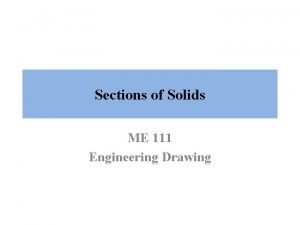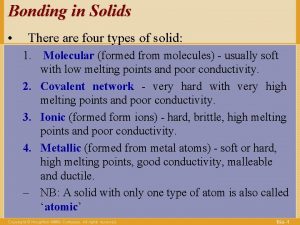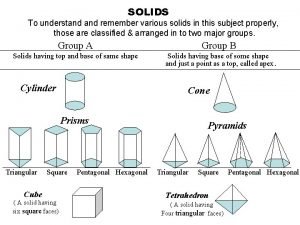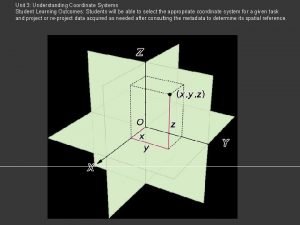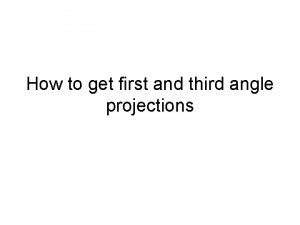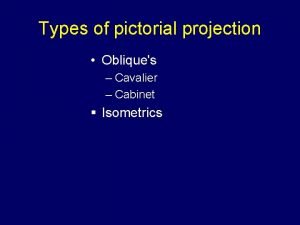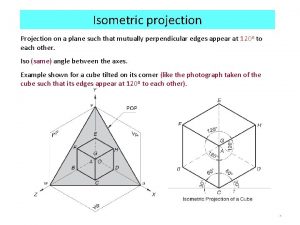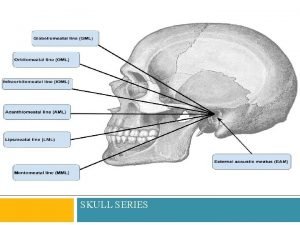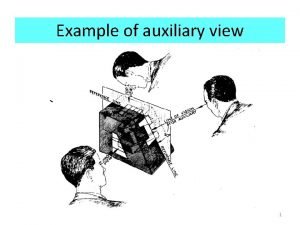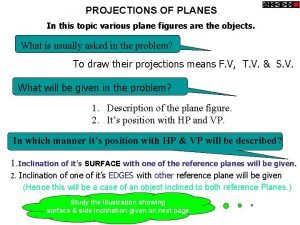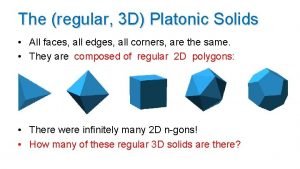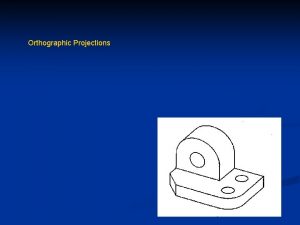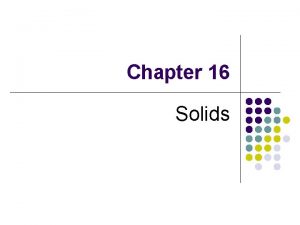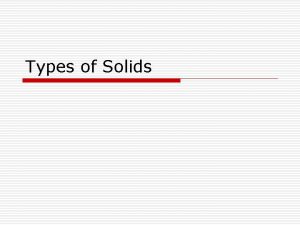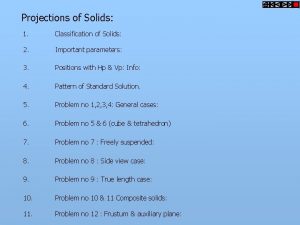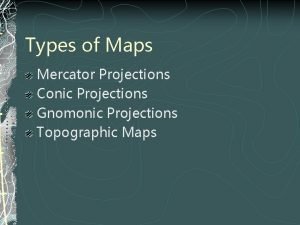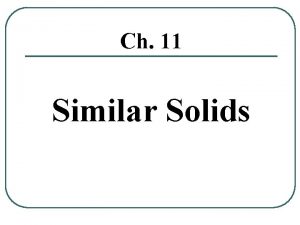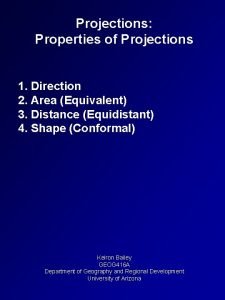PROJECTIONS OF SOLIDS 1 TYPES OF SOLIDS I


























































- Slides: 58

PROJECTIONS OF SOLIDS 1. TYPES OF SOLIDS I. POLYHEDRA A solid that has all faces as flat surfaces and are polygons. A. Regular Polyhedra All faces shall be regular polygons of the same size and shape, and the solid itself shall be symmetrical all around. • • • Tetrahedron has 4 equilateral triangles of the same size Hexahedron (cube) has 6 equal sqares Octahedron has 8 equilateral triangles of the same size Dodecahedron has 12 regular pentagons of the same size Icosahedron has 20 equilateral triangles of the same size

A. Irregular Polyhedra At least one face is either an irregular polygon or a different shaped polygon than the other faces. a) Prisms Has two similar polygons of the same size and parallel to one another as bases, the corresponding sides of which are connected by means of parallelograms. A regular prism is the one that has regular polygons as bases. An irregular prism is the one that has irregular polygons as bases. A right prism is the one that has the axis perpendicular to the bases. An oblique prism is the one that has the axis inclined to the bases.

b) Pyramids Has one polygon as a base, the sides of which are connected to triangles that are also joined together side by side and have one common apex. A regular pyramid is the one that has a regular polygon as base. An irregular pyramid is the one that has an irregular polygon as base. A right pyramid is the one that has the axis perpendicular to the base. An oblique pyramid is the one that has the axis inclined to the base.

II. SOLIDS OF REVOLUTION Solid that are generated by rotating a plane about a line for one revolution. A. Cylinder Generated by rotating a rectangle about one of its side for one complete revolution. Has two flat and one single curved surface. B. Cone Generated by rotating a right angled triangle about one of its perpendicular arms for one complete revolution. Has one flat and one single curved surface. C. Sphere Generated by rotating a semi-circle about its diameter for one complete revolution. Has a double curved surface only.

2. POSSIBLE POSITIONS A. Position of Axis w. r. t. H. P. • • • B. Parallel to the H. P. Perpendicular to the H. P. Inclined to the H. P. Position of Axis w. r. t. V. P. • • • Parallel to the V. P. Perpendicular to the V. P. Inclined to the V. P.

POSITIONS OF A SOLID WITH RESPECT TO THE TWO PLANES 1. Axis parallel to both planes 2. Axis perpendicular to one plane (must be parallel to the other plane) i. ii. 3. Axis Inclined to one plane and parallel to the other plane i. ii. 4. Axis perpendicular to the H. P. (must be parallel to the V. P. ) Axis perpendicular to the V. P. (must be parallel to the H. P. ) Axis inclined to the H. P. and parallel to the V. P. Axis inclined to the V. P. and parallel to the H. P. Axis inclined to both planes

ALWAYS DRAW THE VIEW IN WHICH THE TRUE SIZE AND SHAPE OF THE BASE IS SEEN

Example 1: A pentagonal prism of 25 mm side of base and axis 50 mm long, has its axis parallel to both the planes. One rectangular face of the prism makes an angle of 30 o with the V. P. Draw its projections.

Example 1: A pentagonal prism of 25 mm side of base and axis 50 mm long, has its axis parallel to both the planes. One rectangular face of the prism makes an angle of 30 o with the V. P. Draw its projections.

Example 1: A pentagonal prism of 25 mm side of base and axis 50 mm long, has its axis parallel to both the planes. One rectangular face of the prism makes an angle of 30 o with the V. P. Draw its projections.

Example 1: A pentagonal prism of 25 mm side of base and axis 50 mm long, has its axis parallel to both the planes. One rectangular face of the prism makes an angle of 30 o with the V. P. Draw its projections.

Example 1: A pentagonal prism of 25 mm side of base and axis 50 mm long, has its axis parallel to both the planes. One rectangular face of the prism makes an angle of 30 o with the V. P. Draw its projections.

Example 1: A pentagonal prism of 25 mm side of base and axis 50 mm long, has its axis parallel to both the planes. One rectangular face of the prism makes an angle of 30 o with the V. P. Draw its projections.

Example 1: A pentagonal prism of 25 mm side of base and axis 50 mm long, has its axis parallel to both the planes. One rectangular face of the prism makes an angle of 30 o with the V. P. Draw its projections.

Example 1: A pentagonal prism of 25 mm side of base and axis 50 mm long, has its axis parallel to both the planes. One rectangular face of the prism makes an angle of 30 o with the V. P. Draw its projections.

Example 1: A pentagonal prism of 25 mm side of base and axis 50 mm long, has its axis parallel to both the planes. One rectangular face of the prism makes an angle of 30 o with the V. P. Draw its projections.

Example 1: A pentagonal prism of 25 mm side of base and axis 50 mm long, has its axis parallel to both the planes. One rectangular face of the prism makes an angle of 30 o with the V. P. Draw its projections.

Example 1: A pentagonal prism of 25 mm side of base and axis 50 mm long, has its axis parallel to both the planes. One rectangular face of the prism makes an angle of 30 o with the V. P. Draw its projections.

Example 1: A pentagonal prism of 25 mm side of base and axis 50 mm long, has its axis parallel to both the planes. One rectangular face of the prism makes an angle of 30 o with the V. P. Draw its projections.

Example 1: A pentagonal prism of 25 mm side of base and axis 50 mm long, has its axis parallel to both the planes. One rectangular face of the prism makes an angle of 30 o with the V. P. Draw its projections.

Example 1: A pentagonal prism of 25 mm side of base and axis 50 mm long, has its axis parallel to both the planes. One rectangular face of the prism makes an angle of 30 o with the V. P. Draw its projections.

Example 1: A pentagonal prism of 25 mm side of base and axis 50 mm long, has its axis parallel to both the planes. One rectangular face of the prism makes an angle of 30 o with the V. P. Draw its projections.

Example 1: A pentagonal prism of 25 mm side of base and axis 50 mm long, has its axis parallel to both the planes. One rectangular face of the prism makes an angle of 30 o with the V. P. Draw its projections.

Example 1: A pentagonal prism of 25 mm side of base and axis 50 mm long, has its axis parallel to both the planes. One rectangular face of the prism makes an angle of 30 o with the V. P. Draw its projections.

Example 1: A pentagonal prism of 25 mm side of base and axis 50 mm long, has its axis parallel to both the planes. One rectangular face of the prism makes an angle of 30 o with the V. P. Draw its projections.

Example 2: A pentagonal prism of 25 mm side of base and axis 50 mm long, has its base in the H. P. One rectangular face of the prism is perpendicular to the V. P. Draw its projections.

Example 2: A pentagonal prism of 25 mm side of base and axis 50 mm long, has its base in the H. P. One rectangular face of the prism is perpendicular to the V. P. Draw its projections.

Example 2: A pentagonal prism of 25 mm side of base and axis 50 mm long, has its base in the H. P. One rectangular face of the prism is perpendicular to the V. P. Draw its projections.

Example 2: A pentagonal prism of 25 mm side of base and axis 50 mm long, has its base in the H. P. One rectangular face of the prism is perpendicular to the V. P. Draw its projections.

Example 3: A pentagonal prism of 25 mm side of base and axis 50 mm long, has a side of base in the H. P. The axis of the prism is inclined at 45 o to the H. P. and parallel to the V. P. Draw its projections.

Example 3: A pentagonal prism of 25 mm side of base and axis 50 mm long, has a side of base in the H. P. The axis of the prism is inclined at 45 o to the H. P. and parallel to the V. P. Draw its projections.

Example 3: A pentagonal prism of 25 mm side of base and axis 50 mm long, has a side of base in the H. P. The axis of the prism is inclined at 45 o to the H. P. and parallel to the V. P. Draw its projections.

Example 3: A pentagonal prism of 25 mm side of base and axis 50 mm long, has a side of base in the H. P. The axis of the prism is inclined at 45 o to the H. P. and parallel to the V. P. Draw its projections.

Example 3: A pentagonal prism of 25 mm side of base and axis 50 mm long, has a side of base in the H. P. The axis of the prism is inclined at 45 o to the H. P. and parallel to the V. P. Draw its projections.

Example 3: A pentagonal prism of 25 mm side of base and axis 50 mm long, has a side of base in the H. P. The axis of the prism is inclined at 45 o to the H. P. and parallel to the V. P. Draw its projections.

Example 3: A pentagonal prism of 25 mm side of base and axis 50 mm long, has a side of base in the H. P. The axis of the prism is inclined at 45 o to the H. P. and parallel to the V. P. Draw its projections.

Example 3: A pentagonal prism of 25 mm side of base and axis 50 mm long, has a side of base in the H. P. The axis of the prism is inclined at 45 o to the H. P. and parallel to the V. P. Draw its projections.

Example 3: A pentagonal prism of 25 mm side of base and axis 50 mm long, has a side of base in the H. P. The axis of the prism is inclined at 45 o to the H. P. and parallel to the V. P. Draw its projections.

Example 3: A pentagonal prism of 25 mm side of base and axis 50 mm long, has a side of base in the H. P. The axis of the prism is inclined at 45 o to the H. P. and parallel to the V. P. Draw its projections.

Example 3: A pentagonal prism of 25 mm side of base and axis 50 mm long, has a side of base in the H. P. The axis of the prism is inclined at 45 o to the H. P. and parallel to the V. P. Draw its projections.

Example 3: A pentagonal prism of 25 mm side of base and axis 50 mm long, has a side of base in the H. P. The axis of the prism is inclined at 45 o to the H. P. and parallel to the V. P. Draw its projections.

Example 4: A pentagonal prism of 25 mm side of base and axis 50 mm long, has a side of base in the H. P. and inclined at 60 o to the V. P. The axis of the prism is inclined at 45 o to the H. P. Draw its projections.

Example 4: A pentagonal prism of 25 mm side of base and axis 50 mm long, has a side of base in the H. P. and inclined at 60 o to the V. P. The axis of the prism is inclined at 45 o to the H. P. Draw its projections.

Example 4: A pentagonal prism of 25 mm side of base and axis 50 mm long, has a side of base in the H. P. and inclined at 60 o to the V. P. The axis of the prism is inclined at 45 o to the H. P. Draw its projections.

Example 4: A pentagonal prism of 25 mm side of base and axis 50 mm long, has a side of base in the H. P. and inclined at 60 o to the V. P. The axis of the prism is inclined at 45 o to the H. P. Draw its projections.

Example 4: A pentagonal prism of 25 mm side of base and axis 50 mm long, has a side of base in the H. P. and inclined at 60 o to the V. P. The axis of the prism is inclined at 45 o to the H. P. Draw its projections.

Example 4: A pentagonal prism of 25 mm side of base and axis 50 mm long, has a side of base in the H. P. and inclined at 60 o to the V. P. The axis of the prism is inclined at 45 o to the H. P. Draw its projections.

Example 4: A pentagonal prism of 25 mm side of base and axis 50 mm long, has a side of base in the H. P. and inclined at 60 o to the V. P. The axis of the prism is inclined at 45 o to the H. P. Draw its projections.

Example 4: A pentagonal prism of 25 mm side of base and axis 50 mm long, has a side of base in the H. P. and inclined at 60 o to the V. P. The axis of the prism is inclined at 45 o to the H. P. Draw its projections.

Example 4: A pentagonal prism of 25 mm side of base and axis 50 mm long, has a side of base in the H. P. and inclined at 60 o to the V. P. The axis of the prism is inclined at 45 o to the H. P. Draw its projections.

Example 4: A pentagonal prism of 25 mm side of base and axis 50 mm long, has a side of base in the H. P. and inclined at 60 o to the V. P. The axis of the prism is inclined at 45 o to the H. P. Draw its projections.

Example 4: A pentagonal prism of 25 mm side of base and axis 50 mm long, has a side of base in the H. P. and inclined at 60 o to the V. P. The axis of the prism is inclined at 45 o to the H. P. Draw its projections.

Example 4: A pentagonal prism of 25 mm side of base and axis 50 mm long, has a side of base in the H. P. and inclined at 60 o to the V. P. The axis of the prism is inclined at 45 o to the H. P. Draw its projections.

Example 4: A pentagonal prism of 25 mm side of base and axis 50 mm long, has a side of base in the H. P. and inclined at 60 o to the V. P. The axis of the prism is inclined at 45 o to the H. P. Draw its projections.

Example 4: A pentagonal prism of 25 mm side of base and axis 50 mm long, has a side of base in the H. P. and inclined at 60 o to the V. P. The axis of the prism is inclined at 45 o to the H. P. Draw its projections.

Example 4: A pentagonal prism of 25 mm side of base and axis 50 mm long, has a side of base in the H. P. and inclined at 60 o to the V. P. The axis of the prism is inclined at 45 o to the H. P. Draw its projections.


 Projections of solids
Projections of solids Types of maps ap human geography
Types of maps ap human geography What are two types of solids
What are two types of solids Types of solids
Types of solids Sectional views of solids
Sectional views of solids Viscoelasticity
Viscoelasticity Four types of solids
Four types of solids Angle of pentagonal pyramid
Angle of pentagonal pyramid Sections in engineering drawing
Sections in engineering drawing Scalar projection vs vector projection
Scalar projection vs vector projection Orthographic projection of points
Orthographic projection of points Hp and vp
Hp and vp Drawing newman projections practice
Drawing newman projections practice Isometric projection examples
Isometric projection examples Cyclopentane newman projection
Cyclopentane newman projection Cxr lateral view anatomy
Cxr lateral view anatomy Find the scalar and vector projections of b onto a.
Find the scalar and vector projections of b onto a. Find the scalar and vector projections of b onto a
Find the scalar and vector projections of b onto a Usgs map projections poster
Usgs map projections poster Plantlike organisms that live on dead organic matter
Plantlike organisms that live on dead organic matter Whats missing
Whats missing A point 30mm above xy line is the plan view
A point 30mm above xy line is the plan view Glass box approach
Glass box approach Myriahedral projections
Myriahedral projections Inclined surfaces
Inclined surfaces First angle projection and third angle projection
First angle projection and third angle projection Types of pictorial projection
Types of pictorial projection Size
Size Stereographic projection of point groups
Stereographic projection of point groups Engineering drawing isometric projection
Engineering drawing isometric projection Isometric projections
Isometric projections Lateral maxillary occlusal projection
Lateral maxillary occlusal projection Inclined surfaces in orthographic projections
Inclined surfaces in orthographic projections Convert wedge dash to fischer projection
Convert wedge dash to fischer projection Short numerous hairlike projections for movement
Short numerous hairlike projections for movement Ipl line skull
Ipl line skull Plug figure in pro forma projections
Plug figure in pro forma projections Spain population projections
Spain population projections 4-centre method is used to draw isometric view of a__
4-centre method is used to draw isometric view of a__ Example of auxiliary view
Example of auxiliary view Fingerlike projections
Fingerlike projections True inclination of a line with hp is denoted by
True inclination of a line with hp is denoted by Projections
Projections Projection of plane
Projection of plane Superimposed dimensioning
Superimposed dimensioning Profitability projections
Profitability projections 8-3 dot products and vector projections
8-3 dot products and vector projections A regular pentagon of 30mm sides is resting on hp
A regular pentagon of 30mm sides is resting on hp A regular pentagonal plate has
A regular pentagonal plate has Kv m
Kv m D galactose fischer projection
D galactose fischer projection Surface area of solids
Surface area of solids Wintrobe method
Wintrobe method Solids facts
Solids facts Expansion of solids liquids and gases examples
Expansion of solids liquids and gases examples Semicircle cross section formula
Semicircle cross section formula Why ionic compounds are brittle
Why ionic compounds are brittle Platonic solids 4d
Platonic solids 4d Classifying solids
Classifying solids




